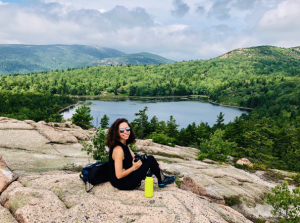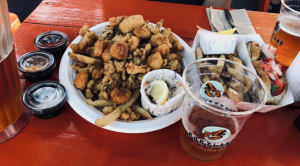Written by Gina Mantica, Biology Ph.D. candidate
Do you find yourself feeling tired? Stressed? Overwhelmed? Do you feel the need to run away from your responsibilities? For a day? A whole weekend? Well, have no fear. There are plenty of places to visit outside of Boston that will leave you feeling relaxed and refreshed—ready for any of the obstacles that grad school decides to throw at you. Check out my top 5 day trips from Medford below!
- Concord
Concord is first up on my list of day trips from the Tufts Medford campus, due to its close proximity and many historical and outdoor activities. Hop on the Concord line commuter rail at North Station and go all the way to the end of the line. Here, you’ll be brought back to the time of Paul Revere. Beautiful colonial homes adorn the streets, including the former houses of both Louisa May Alcott, author of Little Women, and Ralph Waldo Emerson, poet and author of Self Reliance. Walk around the town center, and you’ll find quaint boutique shops and restaurants. My personal favorite is The Concord Cheese Shop—go in and try some free samples! When you’re full, head out of town towards the walking and biking trails of Battle Road, the road Paul Revere, himself, rode on to warn locals that “the British are coming.”
- Rockport
Rockport is next on my list, due it its classic New England beach-town charm. Like Concord, you can grab the commuter rail from North Station all the way to Rockport. The smell of salt water and the sounds of crashing waves will greet you upon arrival. I could (and have) spend the entire day traipsing around Rockport Center. There are a ton of boutique shops to browse in, numerous seafood restaurants to choose from, and countless art galleries to get lost in. While there, make sure to spend some time on the warm, sandy beaches with a cup (or a cone!) of homemade ice cream from The Ice Cream Store. Fun fact: part of the movie The Proposal with Sandra Bullock was filmed in Rockport. Can you figure out which scene while you’re there?
- Provincetown &
- Martha’s Vineyard
I’m grouping these next two together because I love them equally. To get to Provincetown, grab a ferry from Boston Harbor. While drifting out to sea, get ready for a day of frivolity, fun, and entertainment. Perhaps best known for its colorful nightlife, Provincetown offers an abundance of fun daytime activities as well. Like Rockport, Provincetown is awash with cute shops, unique restaurants, and beautiful beaches. If you head to Provincetown early enough, make sure to hit up Victor’s Restaurant for drag brunch—you will not be disappointed.
To get to Martha’s Vineyard from Medford, take a bus from South Station to Woods Hole, and then hop on a ferry to the island. While everything here is a bit more expensive, the scenery is worth the added cost. Beautiful beach houses adorn the coastline, with crystal clear blue waters appearing almost endless in the distance. A must-do while at the vineyard is to walk around and take pictures of the infamous “gingerbread houses.” When done, take the bus or bike on over (the island is very bike-friendly) to the island’s Alpaca Farm, Island Alpaca Company, and make a new, fuzzy friend!
- The Berkshires
Maybe I’m biased because I went to undergrad in Western Massachusetts, but the Berkshires are my absolute favorite day trip from the Boston area. To get there, take a Peter Pan bus from South Station to Northampton. When you arrive, take a deep breath in: clean, crisp, mountain air abounds! Known for its “hipster vibe”, Northampton boasts more vegetarian and vegan-friendly dining options than I ever thought imaginable. For all of you meat lovers out there, there is also El Caminito Steakhouse which boasts Argentinian cuisine and on occasion, amazing live music. After lunch, head over to GoBerry—literally the best frozen yogurt you will ever have. I repeat—THE BEST FROYO EVER. GoBerry uses locally sourced dairy and ingredients from farms in the surrounding area, and the freshness is clear in its taste. Walk around the NoHo (Northampton lingo) town center and check out the numerous boutiques and art galleries. If you’re feeling adventurous, rent a ZipCar and head to Mt. Tom for a scenic mountain hike.



























